+Search query
-Structure paper
| Title | Structures of liganded glycosylphosphatidylinositol transamidase illuminate GPI-AP biogenesis. |
|---|---|
| Journal, issue, pages | Nat Commun, Vol. 14, Issue 1, Page 5520, Year 2023 |
| Publish date | Sep 8, 2023 |
 Authors Authors | Yidan Xu / Tingting Li / Zixuan Zhou / Jingjing Hong / Yulin Chao / Zhini Zhu / Ying Zhang / Qianhui Qu / Dianfan Li /  |
| PubMed Abstract | Many eukaryotic receptors and enzymes rely on glycosylphosphatidylinositol (GPI) anchors for membrane localization and function. The transmembrane complex GPI-T recognizes diverse proproteins at a ...Many eukaryotic receptors and enzymes rely on glycosylphosphatidylinositol (GPI) anchors for membrane localization and function. The transmembrane complex GPI-T recognizes diverse proproteins at a signal peptide region that lacks consensus sequence and replaces it with GPI via a transamidation reaction. How GPI-T maintains broad specificity while preventing unintentional cleavage is unclear. Here, substrates- and products-bound human GPI-T structures identify subsite features that enable broad proprotein specificity, inform catalytic mechanism, and reveal a multilevel safeguard mechanism against its promiscuity. In the absence of proproteins, the catalytic site is invaded by a locally stabilized loop. Activation requires energetically unfavorable rearrangements that transform the autoinhibitory loop into crucial catalytic cleft elements. Enzyme-proprotein binding in the transmembrane and luminal domains respectively powers the conformational rearrangement and induces a competent cleft. GPI-T thus integrates various weak specificity regions to form strong selectivity and prevent accidental activation. These findings provide important mechanistic insights into GPI-anchored protein biogenesis. |
 External links External links |  Nat Commun / Nat Commun /  PubMed:37684232 / PubMed:37684232 /  PubMed Central PubMed Central |
| Methods | EM (single particle) |
| Resolution | 2.85 - 3.22 Å |
| Structure data | EMDB-35575, PDB-8imx: EMDB-35576, PDB-8imy: |
| Chemicals |  ChemComp-Y01:  ChemComp-MG: 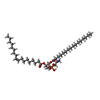 ChemComp-6OU: 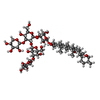 ChemComp-AJP:  ChemComp-CA:  ChemComp-NAG: 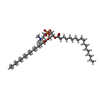 ChemComp-LBN: 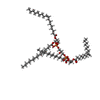 ChemComp-80T:  ChemComp-80Y:  ChemComp-PA1: 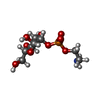 ChemComp-05E: 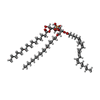 ChemComp-81Q: |
| Source |
|
 Keywords Keywords | MEMBRANE PROTEIN / cryo-EM / glycosylphosphatidylinositol / GPI / GPI anchored protein / GPI-AP / membrane protein complex / proprotein |
 Movie
Movie Controller
Controller Structure viewers
Structure viewers About Yorodumi Papers
About Yorodumi Papers







 homo sapiens (human)
homo sapiens (human) clavularia sp. (invertebrata)
clavularia sp. (invertebrata)